The 60th Anniversary
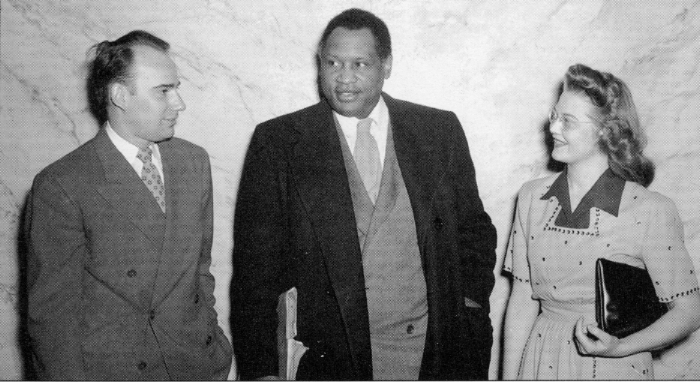
Paul Robeson (center) with Millikin students John Langdon and Faith Nansen (April 18, 1947)
On the morning of Friday, April 18th, 1947, Millikin University's morning classes ended early so that students could assemble in the Albert Taylor Hall for a short, previously unscheduled, free concert performance by Paul Robeson.
It was over and done in less than an hour, and because of its impromptu nature, there were no printed programs, posters or ticket stubs to commemorate the event. And yet, the importance of the man, the circumstances that brought him to Millikin, and where he was headed that night are an intriguing part of U.S. history not often told, yet they happened right here at Millikin.
WHO WAS PAUL ROBESON?
Paul Leroy Robeson was born on April 9, 1898 in Princeton, New Jersey, the son of a runaway slave who had become a minister. Robeson attended Rutgers University and graduated in 1919 as valedictorian of his class and a three-sport star athlete, including having been an “All-American” in football. He then graduated from Columbia University's law school in 1923.
Robeson began pursuing his passion for acting in 1924 and eventually gained worldwide acclaim as both an actor and concert singer. He is perhaps best known for his portrayal of Othello on both the London and New York stages and his rendition of the song “Ol' Man River” in the Jerome Kern musical Show Boat, which he did both on stage and screen. As his fame and stature as a performer grew, he became increasingly outspoken about issues of racism and social reform. It was his sympathetic view of the Soviet Union and radical organizations within the U.S. that brought him under the scrutiny of the House Un-American Activities Committee (HUAC), which for a time even took away his passport to prevent him from traveling abroad. Robeson would eventually move to England in 1958, returning to the US in 1963 where he remained until his death in 1976.
The article below (taken from Millikin's student newspaper) gives a glimpse into the perception of Paul Robeson from a Millikin student perspective five years prior to his performance at the university.
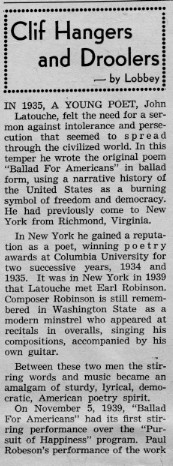
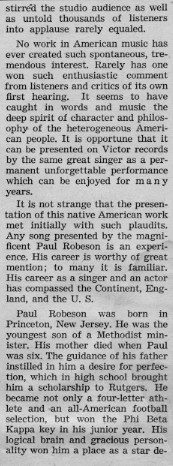

From The Decaturian March 27, 1942 (page 4)
This recording is available in Staley Library
”ROBESON CAME TO MILLIKIN…”
Paul Robeson performed at Millikin University on Friday, April 18, 1947.
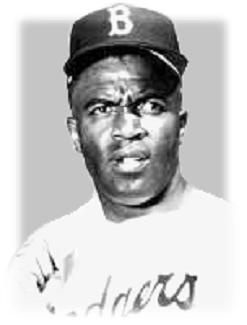
Jackie Robinson
That particular week in history saw Jackie Robinson break the color-barrier in Major League Baseball, the 60th anniversary of which was commemorated by MLB this spring of 2007. That very same day, Tuesday April 15, 1947, also saw the release of a report by the House committee on un-American activities, or HUAC that named close to a thousand people it believed supported the Communist party and its front organizations. Paul Robeson's name was on that list.
[In December of 1943, Paul Robeson had appeared before a meeting of Major League Baseball owners appealing for them to desegregate baseball. After the meeting, baseball commissioner Kenesaw Mountain Landis told reporters that there was no rule or agreement keeping African-American players out of the majors, yet it would still be three-and-half more years before Robinson made his debut. In an ironic twist, Robinson would later testify as the “star” witness “against” Robeson at a July 1949 HUAC hearing, although the actual testimony was fairly mild and was more of an indictment of racism than of Robeson.]
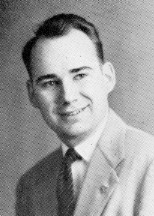
John Langdon
Paul Robeson was scheduled to give a concert in Peoria the evening of Friday, April 18th. That Wednesday, the Peoria city council unanimously passed a resolution that would not allow appearances within their city of any “speaker or artist who is an avowed or active propagandist for un-American ideology,” that was directed at Robeson's appearance scheduled for that Friday. Robeson gave a concert in Champaign that Wednesday night (it was at that concert that two Millikin students, Faith Nansen and John Langdon invited him to Millikin).

Bruce Hayden
Before Robeson took the stage, Millikin student Bruce Hayden played the “Meditation” from “Thais” by Massenet on the violin.
Then Millikin University president Dr. J. Walter Malone introduced Paul Robeson stating that he had agreed to accept the invitation to come to Millikin because of his “deep interest in students and better race relations.” Robeson then took the stage to a thunderous ovation, welcoming him to Millikin even as much of the rest of the U.S. was lining up to make him feel unwelcome. He was ably accompanied on piano by Millikin senior Peggy Apperson.
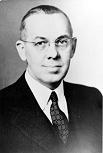
Dr. J.W. Malone
In fact, Robeson marveled at how she was able to transpose her accompaniment "way down for me at first sight, something I never have seen done before.”

Peggy Apperson
He did in fact go to Peoria that night, but was not allowed to speak or perform publicly in that city that night. Paul Robeson was banned from performing in Peoria on April 18th, 1947 because of his political beliefs. It would be the first of many such occurrences in his performing career, as many cities quickly followed Peoria's example. But Robeson did in fact give a little known concert on that day before a large and very receptive audience. An audience comprised of Millikin students & faculty.
STUDENT REACTION AS EXPRESSED IN THE DECATURIAN



From The Decaturian April 25, 1947 (page 1)


Editorials from page 2 of the April 25, 1947 Decaturian
“…BECAUSE OF HIS DEEP INTEREST IN RACE RELATIONS”

The Decaturian April 25, 1947 (front page)
One of the reason's Paul Robeson had come to Millikin in the spring of 1947 was his “deep interest in students and in better race relations,” and he told the students that “he was encouraged to find young people working for the furtherance of race relations.” It is interesting how that statement relates to what was happening on the Millikin campus that very spring.
As shown in the front page image above, that same spring of 1947 saw the opening of the Student Union Building (SUB) on campus. The University Archives had written an article about the SUB for the Fall 2006 Millikin Quarterly to commemorate the 60th anniversary this spring and to further that issue's theme of “Food For Thought: How students have changed campus dining.” The article prompted Millikin alum Jo LoCicero (formerly JoAnn McDonell, class of 1949) to write to the Archives about something we had overlooked in our story.
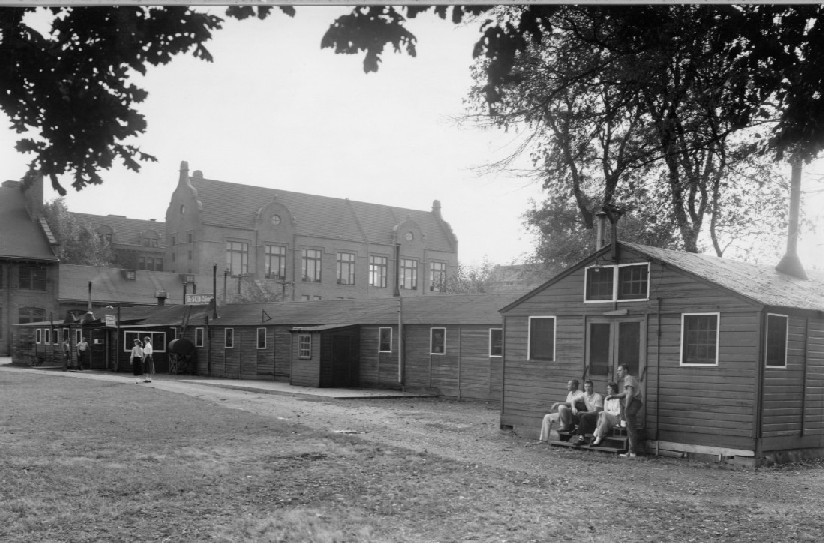
The Sub as it was in the 1940s
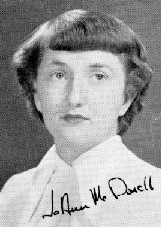
JoAnn McDonell
Although the Quarterly article had contained all the recorded reasons of the hows and whys for the SUB's creation in 1947, LoCicero pointed out that as she read the article she “realized that the real history of what has seemingly become an institution, is unknown.”
According to her account, there were around 10-15 African-American students on campus at that time, most of whom were veterans attending on the GI Bill of Rights (one of the reasons for the SUB cited in the article was the need for a snack bar to feed the large influx of students the GI Bill had brought to campus at the time). These African-American students were not allowed to live or eat on campus, “and none of the nearby restaurants would serve them.” As many of these students were music majors, the Phi Mu Alpha music fraternity's “concern about the health of these veterans/students led them to contact the ACLU…as it was, they existed on candy bars each day.”
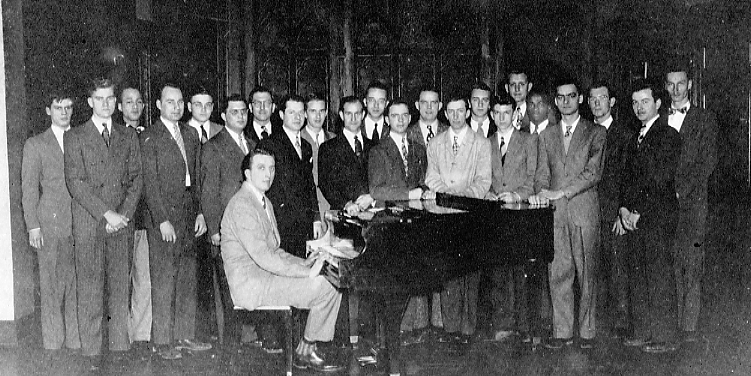
Phi Mu Alpha (Men's Music Fraternity) 1947
LoCicero further recounted that soon after, she was asked to “participate in a sit-in at one of the local ‘greasy spoons'.” On a Sunday night, Phi Mu Alpha president Joe Bearden, African-American music student Elmer Sampson, a member of the ACLU and JoAnn went to a local restaurant but after they had ordered, were informed that “the restaurant was closing and could not take our order,” at which point they left. The next day she remembers being called to the Decatur Herald office and asked about the incident. To the best of her recollection it was shortly after this incident that SUB was up and running which “resulted in ALL of us[Millikin students] having a convenient and less expensive place to eat and meet and it rapidly became the social hub of the campus.” African-American students finally had a place on campus to at least get a meal.
LoCicero concluded her account by stating “there are probably no records of this incident anywhere. It does not matter. It happened. I know it did as I was one of the participants. While this story may make people uncomfortable, it is the truth, and should be acknowledged…from what I can gather in reading the Quarterly, Millikin today is a far better place, for everyone .”
In giving her permission to include this story in the Paul Robeson exhibit, LoCicero told us that she had attended the Robeson performance stating “what an impressive man he was—so eloquent and so imposing—both in style and size.”
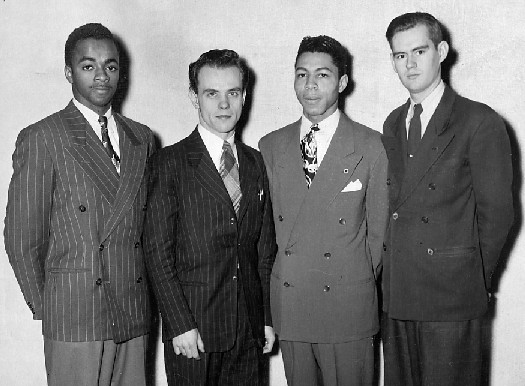
Bruce Hayden, Rollin Smith, Leonard Hawkins, and Hugh Mullins
This quartet, made up of Millikin students Hayden, Smith, and Hawkins and Millikin voice instructor Mullins, performed at a Decatur city-wide brotherhood rally held on February 9, 1947 in conjunction with celebrations for the 38th anniversary of the founding of the N.A.A.C.P. and provides an example of what Robeson described as "young people working for the furtherance of race relations.”
This exhibit was created using information from Millikin's student newspaper, The Decaturian, and the local Decatur newspaper, The Herald & Review. Additional research was done utilizing the following books, all of which are available in Staley Library:
Paul Robeson : a biography / by Martin Bauml Duberman (New York : Knopf, 1988)
Paul Robeson , All-American / Dorothy Butler Gilliam (Washington : New Republic Book Co., 1976.)
Jackie Robinson: race, sports, and the American dream / ed. J. Dorinson & J. Warmund. (Armonk, N.Y. : M.E. Sharpe, c1998.)
This page created May 30, 2007 by Todd Rudat
Last Modified: June 21, 2007
Copyright: Millikin University Board of Trustees